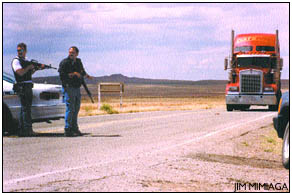|
Nov. 25, 2000 By Jim Mimiaga
The isolation of rural areas caters well to terrorists looking to avoid law-enforcement scrutiny, the Montezuma County commission was told Monday. And the lack of proper training locally to respond to terrorism-related activity ó such as chemical or fertilizer-style bomb-building ó seriously threatens public safety, said Cortez Fire Marshall Frank Cavaliere. "We need to get a handle on potential situations like this," he warned. "Both the World Trade Center and Oklahoma City bombs were put together in rural areas." Cavaliere and county health director Lori Cooper obtained a $2,000 federal grant to study the problem through terrorism simulations and a general-preparedness assessment of local agencies. "After this study we will have more access to grant funding," Cooper said. "There is big money in bio-terrorism and the federal funds donít require a local match." Local law-enforcement agencies, the Department of Justice and the Federal Emergency Management Agency want to train officers to handle the rare but possible scenario of nihilistic schemes being carried out by political-fringe organizations, violent hate groups, or religious zealots. The Justice Department and FEMA provided the grant. Possibilities discussed were the blowing up of McPhee Dam, the intentional poisoning of a water source, major chemical or radioactive spills on area highways, gas-pipeline sabotage, the intentional release of a deadly biological disease, a hostage situation at Mesa Verde whereby the only road in and out is blocked off, or a bomb-making project gone awry. "Groups have been identified in this region that could become involved in situations like these, so we need more preparedness locally to fill the gaps," said Cavaliere. The commissioners were generally agreeable to more specialized training, pointing out that the area has already witnessed an alarming incident in 1998 which had similarities to an organized terrorist attack. That summer, Cortez patrolman Dale Claxton was gunned down by heavily armed "survivalists" who sprayed automatic gunfire at responding officers, injuring two. In the confusion, the camo-clad men easily escaped into the surrounding desert canyons after commandeering a private construction truck from a residence. During a massive, three-month-long manhunt, one of the suspects turned up dead of an apparently self-inflicted wound. A second was found a year and a half after the original incident, also dead apparently by his own hand. The third remains at large. "No one knows for sure what they were planning with that water truck," said Commissioner Kent Lindsay. "This is spooky stuff. And how to build these bombs is spelled out right on the Internet!" More decontamination capability is needed in the area, Cavaliere said. There is no longer a hazardous-material response team locally, so a county HAZMAT team should be organized to pick up the slack, he said, adding that the closest chemical-response team is in Farmington, 1.5 hours away. "None have that kind of training here, which is ludicrous," Cavaliere said. "But it takes time and money that isnít there locally, so we are looking for other sources." Under a three-to-five-year plan, officers would take classes on chemical identification, weapons of mass destruction, quarantines, clean-up and response, and decontamination procedures. Southwest Memorial Hospital would be a key player in any bombing, chemical warfare, or disease-related disaster, because of its trained medical staff and decontamination equipment that includes an instantly erected isolation unit with showers. |
||
|
Copyright © 2000 the Cortez Journal.
All rights reserved. |
